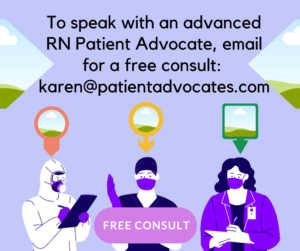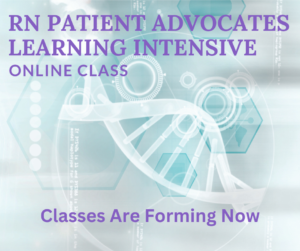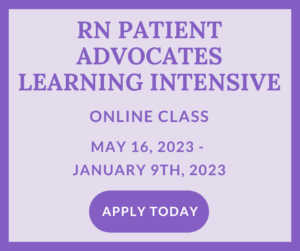Always an Advocate…
I was always the family patient advocate. That the system was broken became more and more obvious over the years as I worked on their behalf. I was a patient advocate in the clinical arena as well, though that too was becoming increasingly difficult. By 2002, I became utterly frustrated with my inability to advocate fully for my patients. Bound by hospital and health plan restrictions and the overwhelming clinical responsibilities that left little time for advocating for my patients, I decided to opt for direct patient centered advocacy – as an independent.
Creating a way forward…….what do patients need?
Looking all over the nation for a program, I found none and so began the RN Patient Advocacy Program. I needed to create a model: what services did patients need most? Certainly advocacy on their behalf – asking those questions patients and their families don’t know how to ask and also looking for gaps in care and spotting potential problems. Patients and their families also need a great deal of education – health literacy teaching. Compliance with treatment plans often falters because people do not understand what they are doing.
Also I saw the need for facilitating communication between providers. Physicians are often unaware of treatments, history and medications patients obtain through other physicians or providers. When patients go to the emergency room, who is providing a thorough history? What impact on treatment choices does an incomplete history create?
How about treatment options? Who actually sits down with patients and their families to explain the different treatment modalities available. Just how informed are they when they sign on the dotted line? Informed choice? Oftentimes not…….
As a component of this, I saw the need to research and teach treatment options that included the expanded therapeutics research was opening up: Integrative and Functional Medicine approaches to chronic, degenerative and autoimmune illness.
Then I thought about how patients and families actually make the choices that directly impact the quality and quantity of their lives. They are going through the change process, evaluating new and strange information. Who is guiding them?
How about evaluating the teams who implement the chosen treatment plan? Who looks at qualifications?
These were the areas I felt needed immediate attention. So I began, patient by patient.
Independent practice…….a new learning curve
I had to learn the business end: how do I practice independently? What are the legal and insurance ramifications? How do I get patients? I went to the Small Business Development Center, SCORE and women’s business groups for support and information. It took me a while, but I wrote my first business plan to forge my map forward. That was pretty interesting and not as hard as I thought.
Reality…….how to approach a patient as an iRNPA?
My first big case was a friend; her daughter called me and said that she thought that her Mom was dying – falling through the cracks. I went to see her and she truly was in danger of dying. The wrong surgery had been done, she was septic and the hospitalist had not called in an Infectious Disease doctor (!), drainage from her wound was purulent, her central line was bright red and the dressing falling off……… My patient was on a team with 12 other very ill patients and she was suffering from lack of appropriate care. It took 4 weeks of close collaboration with the hospitalist group and the specialists finally consulted to effect a successful discharge for her to a rehab facility. More problems ensued as you can imagine.
Patients started calling me as the word spread. What was emerging back then – patient by patient – was a highly effective model of direct patient advocacy that tremendously improved my patient’s outcomes. Also, I began to see just how much money this process saves the system.
Charge for my time? Making a living…….
It was so clear to me that what I was doing was critically important to my patient’s survival and healing. More patients found me and I learned how to get my message out.
It can be difficult to learn to charge for your services – but I realized how valuable my knowledge and expertise is. This element is key in becoming an independent RN Patient Advocate.
Doctors start thanking me….
The more physicians I worked with, the more open and accepting they became about working together. Face it, their patients who worked with me did better than many who did not. Also, my work made their lives easier and made them look good. They saw the benefits of reducing the risk of medical errors, becoming more aware of their patients’ full histories as well as the work done by their peers on those patients, and the value of the increasing levels of health literacy of their patients.
Nurses rally to learn about this new career
Nurses began to call and email from all over the nation as well as from Canada and as far away as Saudi Arabia! Experienced clinical RNs were becoming as frustrated as I with the system and looking for alternative ways to stay in the field, utilizing their knowledge and skills more effectively. There just aren’t that many choices beyond the clinical arena for clinical RNs.
However, I wasn’t ready to teach yet. I had to see if the emerging model worked in every possible application. Seven years into patient care using the Patient Advocacy Model I knew it was time to help other RNs do what I was doing – to experience the excitement and joy of direct patient advocacy.
The door opens….moving forward together
Working with academic RNs, I created the curriculum and began to teach in September, 2009. This first class showed me also that we need to be joined together in a team to help one another – though we each have our own practice. The National Network of RN Patient Advocates was born.
Then, a few weeks after that first class, something very wonderful happened: the College of Nursing at the University of Arizona asked to partner with us! They recognized that this RN Patient Advocate program is leading edge and represented a new branch for the profession of nursing.
Pure nursing……at last
Finally – an integration of clinical, academic and entrepreneurial practice is here for all of us to develop. We clinical RNs can utilitze all of our knowledge and experience doing what we know should and must be done to best advocate for, educate and guide our patients and families. No prescribing, no diagnosing, not hands on task assignments – just pure nursing. We need knowledge, creativity, a willingness to work together to continue to develop this innovative new role.
Giving patients both the fish and the fishing pole…….
Together, we clinical RNs can be positive agents for change in the health care system of the US. Through our efforts, our patients benefit twice: first in the improved outcomes/cost savings in management of their immediate health problems and then secondly, by learning why and how to advocate for themselves.
It is this last part that holds such hope for our nation’s health care system: to facilitate patients becoming active agents in their own care so they are not so vulnerable.
I saw again and again how patients – given these tools – taught their families and friends how to do this as well. Imagine the changes we can create as we work together in our National Network as independent RN Patient Advocates. We have much to do……..





Recent Comments